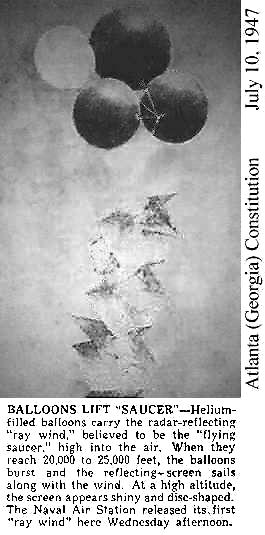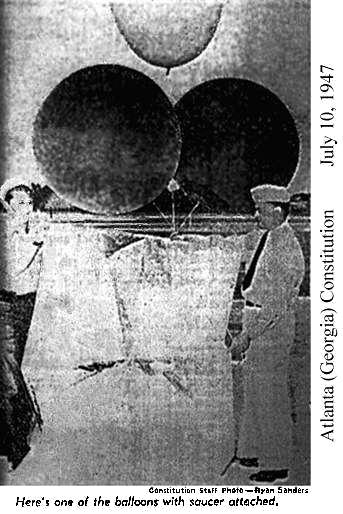July 10, 1947, Atlanta (Georgia) Constitution, Front Page
'SAILING SAUCER' SECRET SOLVED?
--The Answer Here
By Katherine Barnwell
A "flying saucer," silvery in the sun, sailed over Stone Mountain Wednesday.
It wasn't a paper plate or runaway kite or a figment of an inebriate's imagination.
It was, officers at the Naval Air Station believe, a genuine "flying saucer" the answer to the recent perplexing puzzle plaguing the country's collective brains.
Lt. Comdr. Thomas H. Rentz, of the Naval Air Station, said the mysterious sailing discs that have been baffling the nation are without doubt "ray winds," or tinfoil screens borne aloft by balloons. The screens are used, he said to reflect radar rays and determine the velocity of the wind at various altitudes.
And just to prove that "ray winds" could be mistaken easily by the layman for "saucers," Cmdr. Rentz arranged a demonstration.
At a cost of $25, Lt. Rell Zelle Moore, aerology officer at the Air Station, launched a "ray wind," the first ever to be released here, and the shining object was carried by helium-filled balloons off into the blue and white yonder.
Lt. Moore explained that when the balloons reach about 25,000 feet, they burst. The silver screens which they are carrying then are caught in the wind, and sail along at a speed up to 15 miles an hour.
Although the "ray wind" released here Wednesday was about four-by-ten feet, it appeared completely round at a high altitude. The tinfoil is stretched on crossbars of light balsam wood, somewhat similar to a box kite.
Lt. Moore said that the distance of the "ray wind" and its angle from the ground can be determined by radar. The mathematician, juggling the time since release, the distance and the angle, can then arrive at the wind velocity for each 1000 feet.
"Wind velocity," he commented, "is very important to the aviator."
Although the "ray wind" was invented several years ago, its use became general only recently.
"People are just beginning to see these things," reasoned Comdr. Rentz, "and that's probably why they are all excited about them now."
A. W. Pruitt, Aerographer's Mate, who helped launch the "ray wind," glanced up at the shining disc as it zoomed over Stone Mountain and pronounced:
"Well, there'll be a lot of people who won't have to rely on the bottle to see a 'flying saucer' today!"
July 11, 1947, Front Page
NAVY PLANE IN CHASE OF 'SAUCER'
--'Raywin' Again
By Katherine Barnwell
A "flying saucer" sailed through Georgia skies again Thursday. "This time, a Navy plane was chasing it," said Lt. Cmdr. Thomas H. Rentz, of the Naval Air Station. "It looked like a stack of saucers."
To record the picture of "chinaware" in the sky for posterity, the Naval Air Station sent a plane up 8000 feet to photograph the phenomenon.
The "flying saucer" has been identified by officers at the Naval Air Station here as a "raywin" or a radar-reflecting screen borne aloft by balloons for the purpose of determining wind velocity at various altitudes.
The "raywin" released Thursday was the second was the second "saucer" demonstrated by Lt. Zelle Moore, aerology officer at the Air Station. He launched the first Wednesday.
Several hours after the "flying saucer" or "raywin" was released Thursday, Mrs. Henry Johnson of Route 2, Clarkston, found it hanging on a tree limb.
"My little boy first saw it in the air," she related, "and thought it was a parachute coming down I knew what it was, because I had seen pictures of it in The Constitution.
"We watched it about 10 minutes before it fell, and it was glittery and shaped kind of like a triangle. We started walking in the direction it fell, and walked about a mile, I guess. It was in a tree. There was a farmer standing by it, wondering what in the world it was We took it home with us."
The pilot of the plane which photographed the "raywin" Thursday watched the helium-filled balloons carry it up about 15,000 feet.
Lt. Moore explained the balloons burst when they reach 20,000 to 25,000 feet. Then the screen, which is merely tinfoil on crossbars of light balsam wood, is carried along by the wind. At a high altitude it is shiny and appears round.
"It undoubtedly is the 'flying saucer,'" said Cmdr. Rentz, who added he heard a $3000 reward was offered "by someone" for a real "saucer."
"Do you suppose we could collect the reward?" he asked, smiling.
Cmdr. Rentz said, after Wednesday's story describing "raywins" appeared in The Constitution, several news and picture services sent representatives to the Air Station to see a "saucer" fly. Chief Frank F. Roberts, in the Aerology Department at the Naval Air Station, said he had checked newspaper reports of persons who had spotted "flying saucers," and in every case they were near a radar unit using "raywins."
Navy Spends $25 to Show Facsimile 'Flying Saucer'
(Charleston (S.C.) News and Courier, front page)
Flying Saucers Actually Being Seen, Navy Proves
(Baton Rouge State Times & Sunday Advocate,
front page)
Atlanta, Ga. July 10 -- It cost the Navy $25 today to prove to its own satisfaction that flying saucers seen throughout the nation are real.
Terming the mystery discs "ray winds," veteran officers at the Atlanta Naval Air station set out to prove their contention that there is nothing imaginary about the saucers.
Lt. Rell Zelle Moore, aerology officer at the air station, launched a "ray wind."
The genuine "flying saucer" -- in reality a tinfoil screen carried aloft by balloons -- sailed over Stone mountain looking silvery in the sun.
Almost immediately the calls began pouring into newspaper offices here describing the round-looking saucer which shone like aluminum.
And the naval air experts nodded wisely at their saucer-launching station.
Lt. Commander Thomas H. Rentz, one of the officers taking part in the demonstration, explained that the "ray winds" -- or tinfoil screens -- are carried off by helium-filled balloons until they reach an altitude of 25,000 feet. The tinfoil is stretched on crossbars of light wood on the same principle of a box kite.
The balloons burst, Rentz continued, and the silver screens are caught in the wind and sail along at speeds up to 165 miles an hour.
The screens are used to reflect radar rays and determine the velocity of the wind at varying altitudes, Rentz said.
The "ray wind" released in the demonstrations was four-by-ten feet, bt aloft it appeared completely round. Materials used in the show cost the navy $25, officers said.
The distance of the "ray wind" and its angles from the ground can be determined by airmen by radar. By calculating the time since release, the height and angle, they can arrive at the wind velocity -- of primary importance to aviators -- for each 1000 feet of altitude.
Invented several years ago, the "ray wind" has only recently come into general use.
"People are just beginning to see these things aloft." Rentz added that "they're real all right."
Navy Spends $25 Cash to Prove Disks Illusions
(Long Beach (CA) Press-Telegram, p. 2)
Navy Balloon Test Brings Flood of 'Saucer' Reports
(Santa Barbara (CA) News Press, front page)
Disks Called Weather Devices
(Denver Post)
'Disks' Debunked -- Gromyko, US Navy Agree!
(Eugene (OR) Register-Guard, front page)
Practical Jokers Carry Ball for Flying Discs
(Portland Oregon Journal)
Pranksters Have Day, Navy Explodes 'Flying Disc'
Myth
(Sacramento (CA) Bee)
Practical jokers continued to have a high time with flying saucers today as the navy advised the more serious minded "eyewitnesses" that what they saw in the sky were only weather observation devices.
It cost the navy $25 to assure itself. Lieut. Rell Zelle Moore, naval air station aerology officer, launched a "ray winds" weather device in a $25 "operation saucer" at Atlanta, Ga. As the helium-filled balloon carrying a tin-foil screen soared over Stone mountain, calls poured into Atlanta newspapers reporting "flying discs."
The 4 by 10 foot screen looked like a round aluminum disk at a high altitude.
Russell Long, North Hollywood construction engineer, found a 25-inch metal disk with radio tubes flashing and smoking in his flower garden and excitedly called the Fire Department. "It looks like someone went to a great deal of trouble for a joke," said Battalion Chief Wallace F. Newcombe of the Los Angeles Fire Department.
Adrei I. Gromyko, Soviet Deputy Foreign Minister and delegate to the United Nations, vetoed suggestions that the "flying saucers" were of foreign origin.
"Some attribute it to the British for exporting too much of their Scotch whiskey to the United States. Some say it is a Russian discus-thrower training for the Olympic Games who does not realize his own strength. I do not think these versions are correct," said Gromyko.



